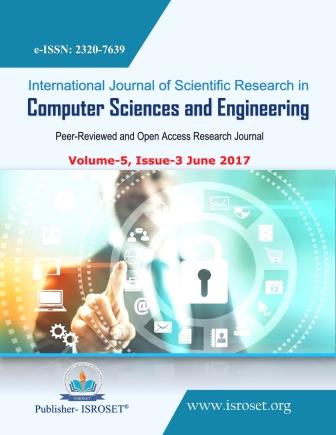Phylogenetic Tree Construction for Distance based Methods
Keywords:
Phylogenetic tree, FASTA, Basic Local Alignment Search Tool, Hidden Markov ModelAbstract
Bio-informatics is an upcoming area resulting from the combination of bio-technology and computer science. All the findings in bio-informatics are stored and utilized with the help of computer science to get the constructive results and elaborations. Phylogenetic trees are constructed from the molecular sequences of the different living organisms. These are actually needed to evaluate the relation between the different species and also the different time gaps from the actual origin. Sequence alignment is one of the applications of bioinformatics. Multiple Sequence Alignment is used to align the biological sequences along a column. Multiple sequence alignment arranges the sequences in such a way that evolutionarily equivalent positions across all sequences are matched. The process starts by generating distances of multiple alignments among the pairs of different species, then a phylogenetic tree is being formulated. Further, taking different data sets, bootstrapping of phylogenetics and consensus trees are being shown. Web based FASTA sequences are considered as input.
References
Kakiuchi, I. and Kimura, M. (2011), “Characterization of a new neighborhood determined by three parameters”, Technical Report of the NAS, pp. 1-11.
Vijan, S. and Mehra, R. (2011), “Biological Sequence Alignment for Bioinformatics Applications Using MATLAB”, IJCSET, vol. 2, 5, pp. 310-315.
Zhou, J., Sander, J., Cai, Z., Wang, L. and Lin, G. (2010), “Finding the Nearest Neighbors in Biological Databases Using Less Distance Computations”, IEEE/ACM Transactions on computational biology and bioinformatics, vol. 7, 4, pp. 669-680.
Zimek, A., Buckwald, F., Frank, E. and Kramer, S. (2010), “A Study of Hierarchical and Flat Classification of Proteins”, IEEE/ACM Transactions on computational biology and bioinformatics, vol. 7, 3, pp. 563-571.
Liu, C. and Wang, F. (2012), “Pair-wise sequence alignment algorithm in bioinformatics”, EEESym.2012, pp. 36-38.
Shehab, S.A., Keshk, A. and Mahgoub, H. (2012), “Fast Dynamic Algorithm for Sequence Alignment based on Bioinformatics”, IJCA, vol. 37, 7, pp. 54-61.
Mukunthan, B., Nagaveni, N. and Pushpalatha, A. (2011), “Identification of unique repeated patterns, location of mutation in DNA finger printing using AI technique”, Journal of Bioinformatics and Sequence Analysis, vol. 3, 6, pp. 100-115.
Naznin, F., Sarker, R. and Essam, D. (2010), “DGA: Decomposition with genetic algorithm for multiple sequence alignment”, CIBCB 2010, pp. 1-8.
Lesk, A.M. (2002), “Introduction to Bioinformatics”, Oxford University Press, pp 180-200.
Lin, X., Meng, Z., He, X., Liu, Q., Liu, Y., Li, J. and Zhou, Y. (2010), “A solution to integrate the phylogenetic tree’s generation based on web”, ICBBE2010, pp. 1-3.
Huson, D.H. (2009), “Drawing Rooted Phylogenetic Networks”, IEEE Transactions on computational biology and bioinformatics, vol. 6, 1, pp. 103-109.
Miyazawa, S. (2011), “Advantages of a Mechanistic Codon Substitution Model for Evolutionary Analysis of Protein-Coding Sequences”, PLoS ONE, vol. 6, 12, pp. 54-69.
Mount, D.W. (2004), “Bioinformatics: Sequence and Genome Analysis”, 2nd ed. Cold Spring Harbor Laboratory Press: Cold Spring Harbor, NY.. ISBN 0-87969-608-7.
Bogdanowicz, D. and Giaro, K. (2012), “Matching Split Distance for Unrooted Binary Phylogenetic Trees”, IEEE/ACM Transactions on computational biology and bioinformatics, vol. 9, 1, pp. 150-160.
Nakhleh, L. (2010), “A Metric on the Space of Reduced Phylogenetic Networks", IEEE/ACM Transactions on computational biology and bioinformatics, vol. 7, 2, pp 1-5.
Sundaravardhan, N., Patnaik, D., Marwah, M., Shah, A. and Ramakrishnan, N. (2012), “System and method for tree discovery”, United States Patent Application Publication, Pub. No.: US 2012/0185421 A1
Krane, D. and Raymer, M. (2006), “Fundamental concepts of bioinformatics”, Pearson Education Publishers.
Pevsner, J. (2009), “Bioinformatics and Functional Genomics”, A john wiley & sons, Inc. Publication, pp 215-221.
Rastogi, S.C., Mendiratta, N., Rastogi, P. (2007), “Allignment of Multiple Sequences and Phylogenetic Analysi-Bioinformatics Methods and Applications”, 3rd edition, PHI publication, pp. 5-120.
Wang, Y., E. and Sheth, D., N. (2011), “ Methods and collective reasoning framework for complex decision making”, United States Patent Application Publication, Pub. No.: US 2011/0320374 A1
Heard, E. J., Riechmann, L. J., creelman, A. R., Ratkliffe, O., canals, D. R., Repetti, p. P., Kumimoto, W. R. and Libby, M. J. (2010), “Plant transcriptional regulators”, United States Patent Application Publication, Pub. No.: US 2010/0175145 A1
Torres, M., Dias, G., Gonçalves, G. and Vieira, C. (2011), “Tool that Integrates Distance Based Programs for Reconstructing Phylogenetic Trees”, IEEE latin america transactions, vol. 9, 5, pp. 895-901.
Gronau, I., Moran, S. and Yavneh, I. (2010), “Adaptive Distance Measures for Resolving K2P Quartets: Metric Separation versus Stochastic Noise”, Journal of Computational Biology, vol. 17, 11, pp. 1509-1518.
Wang, L.S., Leebens-Mack, J., Wall, P.K., Beckmann, K., DePamphilis, C.W. and Warnow T. (2011), “The Impact of Multiple Protein Sequence Alignment on Phylogenetic Estimation”, IEEE/ACM Transactions on computational biology and bioinformatics, vol. 8, 4, pp. 1108-1119.
Xiong J., (2006), “Essential Bioinformatics”, United States Of America, Cambridge University Press, New York.
Guo, P., Chen, G. and Wang, Y. (2011), “Constructing phylogenetic tree based on three-parameter model”, Key Engineering Materials, vol. 474-476, pp. 2193-2197.
Sul, J., S. and Williams, L., T. (2009), “An experimental Analysis of consensus tree algorithms for large-scale Tree Collections”, ISBRA, LNBI 5542, pp 100-111.
Rwahnih, A. M., Turturo, C., Minafra, A., saldarelli, P., Myrta, A., Pallas, V. and savino, V., “Molecular variability of apple chlorotic leaf spot virus in different hosts and geographical regions”, journal of plant pathology, pp 117-122.
Downloads
Published
How to Cite
Issue
Section
License

This work is licensed under a Creative Commons Attribution 4.0 International License.
Authors contributing to this journal agree to publish their articles under the Creative Commons Attribution 4.0 International License, allowing third parties to share their work (copy, distribute, transmit) and to adapt it, under the condition that the authors are given credit and that in the event of reuse or distribution, the terms of this license are made clear.







